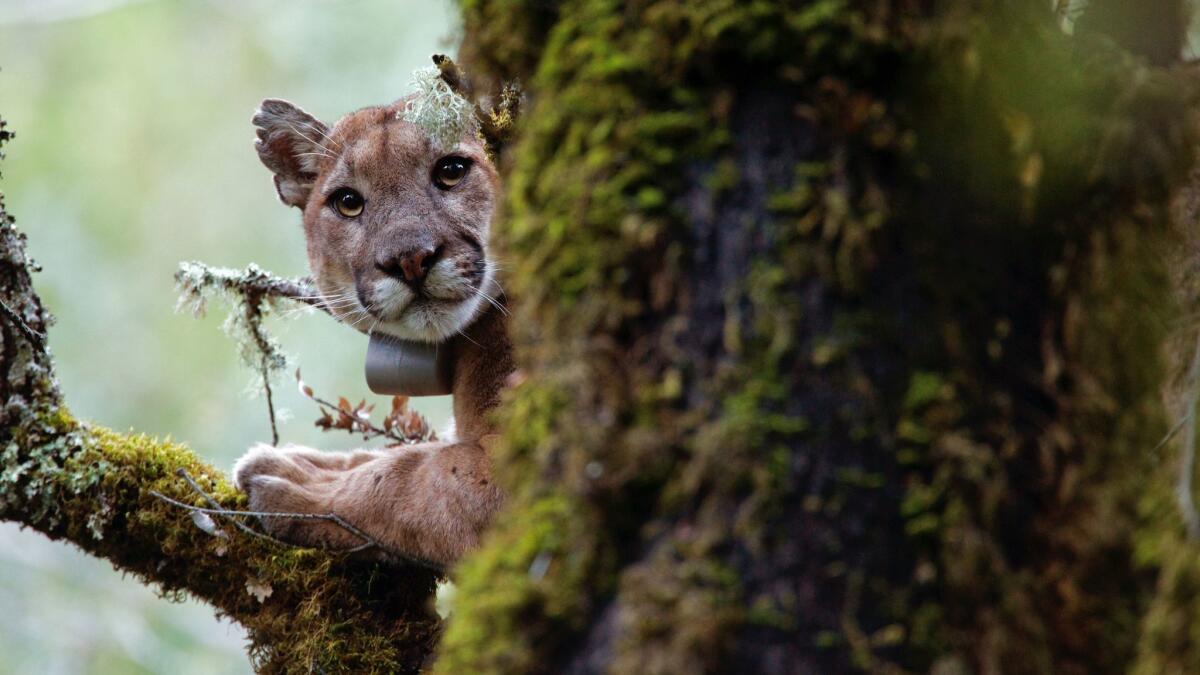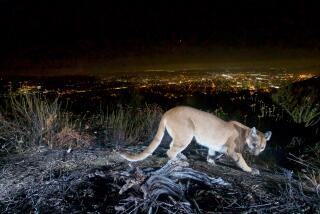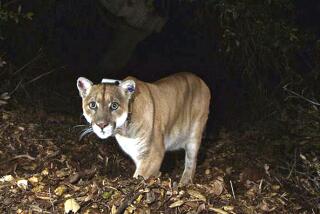How a fear of humans affects the lives of California’s mountain lions

Pumas may be the top carnivores in much of California’s mountains, but there’s still one predator they fear above all else: humans.
When mountain lions hear the sound of human voices, they almost always flee, even if it means abandoning their prey, according to a new study from scientists at UC Santa Cruz and the Santa Cruz Puma Project.
The findings, published this month in Proceedings of the Royal Society B, may not come as a surprise to anyone familiar with the notoriously elusive predators, but they may have implications for the species’ and ecosystem’s health that cause concern.
Since 2008, researchers have been monitoring pumas in the Santa Cruz Mountains, where the cats are no strangers to humans. There, pumas can live and hunt in close proximity to people and have been known to kill deer and other animals within 20 feet of houses.
However, researchers have noticed that the animals behave strangely around human habitats.
Normally, mountain lions ambush their prey and stash the carcass nearby, allowing them to feast over several nights.
But when people are nearby, female pumas tended to abandon or eat less of their kill. To compensate, the cats killed more deer in these areas, according to a 2015 study.
Perhaps, the researchers thought, the pumas were avoiding potential encounters with people.
To find out, Justine Smith, then a doctoral student in environmental studies at UC Santa Cruz, set up camera traps to record the nocturnal predators as they returned to the sites where they stashed their prey.
The devices were rigged to randomly play one of two audio clips: either a snippet from a talk radio program or the nonthreatening chirping of Pacific tree frogs, which are common to the soundscape of the Santa Cruz Mountains. (If the cat returned, it would hear the other sound.)
Ten of the 12 cats that encountered the talk radio program bolted immediately upon hearing the sound of human voices. A total of 17 cats heard the frog sounds, but only one — a skittish older male that often kills domestic animals — fled in response.

Mountain lions flee the sounds of human voices.
Among the pumas scared away by human voices, only about half returned to feed on their carcass. Even then, frightened pumas took significantly longer to come back to their kill sites and spent half as much time eating, compared with those that heard the frog sounds.
“We anticipate that every single one of these pumas has come across human voices in its life, possibly many times,” said Smith, now a postdoctoral researcher at UC Berkeley. “I think they’re aware of people and that they try to avoid them.”

A mountain lion does not react to hearing a recording of tree frog vocalizations, but later bolts away from its kill when it hears the sounds of human voices.
Mountain lions have good reason to fear humans.
Historically, the big cats’ relationship with man has not been friendly. In the 1940s, mountain lions were hunted for $25 to $35 per pelt in California and other states. In 1990, California banned the practice, designating mountain lions a “specially protected species,” although they’re not considered endangered or threatened.
Today, humans still are the leading cause of death among mountain lions, thanks to vehicle strikes, rodenticide poisoning and the state-sanctioned hunting of mountain lions that have killed livestock or pets.
“Clearly these animals should be afraid of us because of the dramatic impact people have on their survival,” Smith said. “This fear response might help them in some ways to coexist with us.”
It’s unclear, however, whether mountain lions directly associate humans with death because the animals often are killed indirectly by guns or cars, Smith said.
The new research results, combined with findings from the 2015 study, suggest a fear of humans has caused some pumas to alter their feeding behavior. That could affect the animals’ survival rates — and the ecosystem as a whole.
Because the pumas in developed areas spent less time eating, they had to kill more deer to get enough food to survive. More time spent hunting can mean less time caring for young.
A female mountain lion in the most developed area of the Santa Cruz team’s study area has lost three litters of kittens in as many years, one because of abandonment, researchers previously noted. Other females in less-developed regions saw much better kitten survival.
Hunting also is a risky activity. Bringing down an adult deer requires a lot of energy, even for a large mountain lion, and the ungulates’ powerful hooves could break a cat’s jaw, said John Benson, a University of Nebraska wildlife ecologist who has studied pumas in the Santa Monica Mountains.
When a mountain lion kills a deer, it typically picks the carcass clean, Benson said. But if it’s scared away from its dinner, the cat likely would have to kill again.
“That could disrupt the balance between predator and prey,” Benson said.
He added that much of what we know about wildlife is based on studies of remote areas, where humans are not part of the equation.
“We assume this balance between predator and prey,” he said, but that balance may be “distorted in areas where there are humans.”
The missing side of the story is the deer’s perspective. Little research has been done on mule deer populations, or how mountain lions and humans influence them.
With more abandoned carcasses around developed areas, scavengers such as vultures and smaller mammals may find more to eat, researchers noted.
“We have a lot more to learn about the consequences of these changes before we know what we’re dealing with,” Smith said.
She did see a silver lining, however. Mountain lions have found a way to live alongside humans, and although the cats are relatively common, it’s still quite rare for a person to see one in the wild.
The Santa Cruz Puma Project publishes GPS data that track mountain lions on a six-week delay so people can “see who their neighborhood puma is,” Smith said.
“For some, that’s frightening, but for others, it’s heartening because they know they’re staying hidden and not bothering anyone,” she said. “They can use our habitats, but they stay out of the way so that we don’t feel threatened or unsafe.”
MORE IN SCIENCE
As lawmakers debate GOP healthcare bill, new study finds stripping people of insurance can be deadly
Scientists make water bottles the old-fashioned way to see if they were toxic to early Californians
Why are some eggs round and others pointy? It may have to do with how well a bird flies







